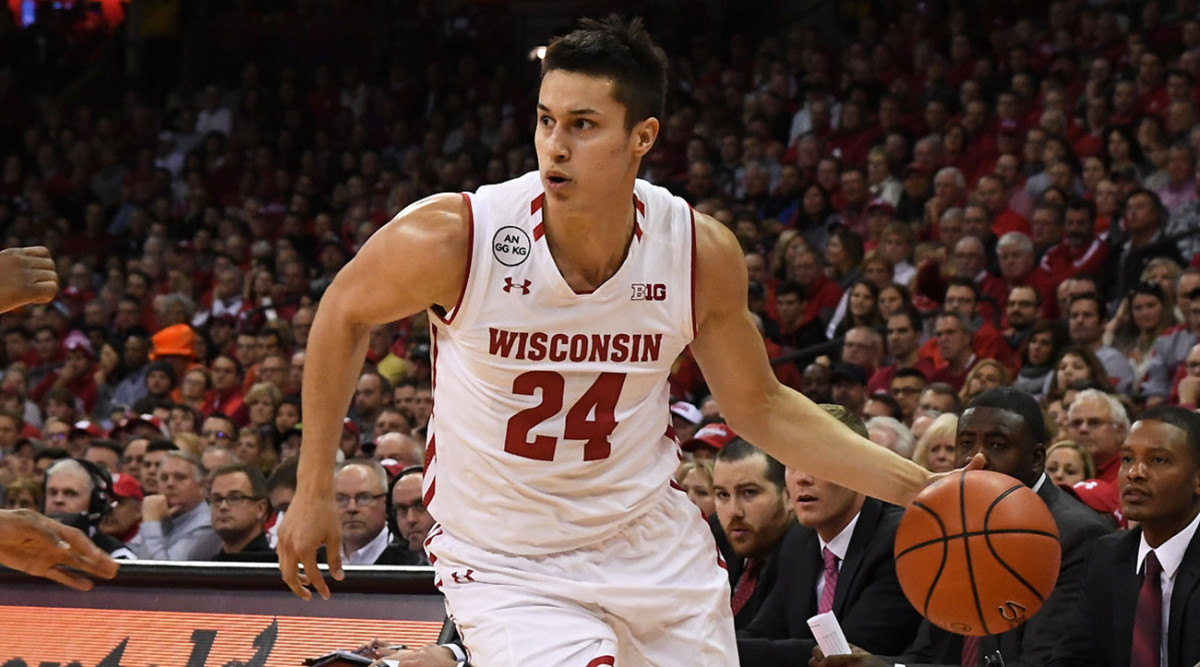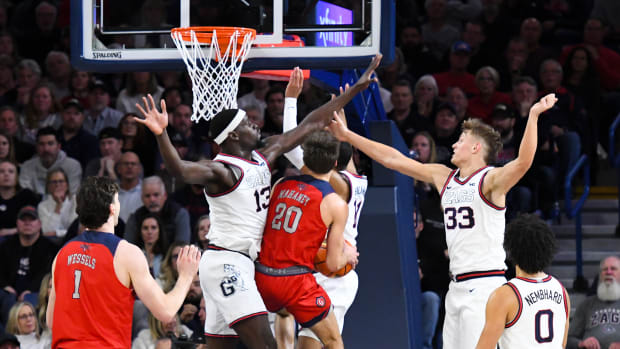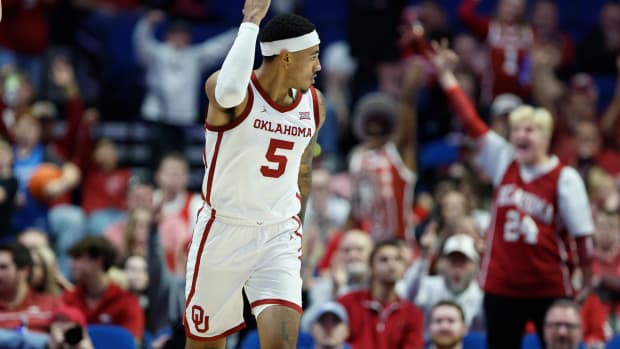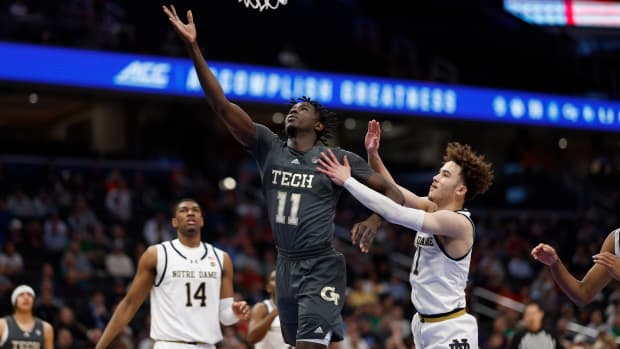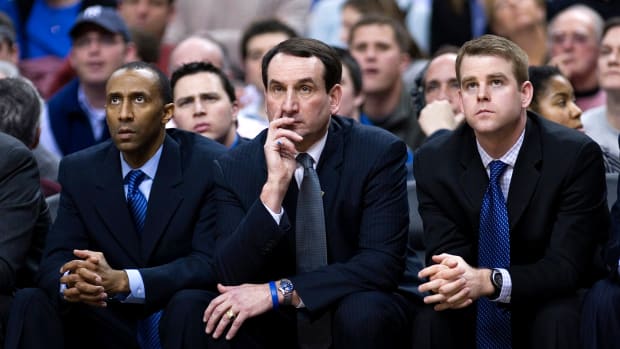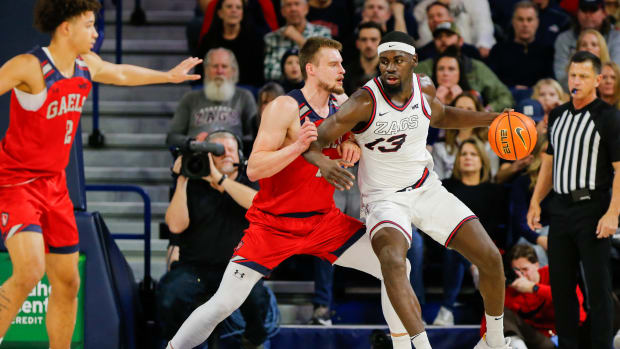Face of a Nation: Bronson Koenig embracing prominent role among Ho-Chunk people
This story originally appeared in the Dec. 12, 2016, issue of Sports Illustrated. Subscribe to the magazine here. And watch Wisconsin take on Marquette on Fox Sports 1 or Fox Sports Go on Saturday at 2 p.m. ET.
They had traveled more than 100 miles to visit with him for just a few minutes, but he had no desire to talk, no idea what to say. Still, his mother had asked him to follow through on his commitment, so Bronson Koenig walked into a small conference room at the Holiday Inn in Lincoln, Neb., and sat across from the basketball players from Winnebago (Neb.) High. It was March 2014, and Koenig was a freshman point guard for Wisconsin, getting ready to play the Cornhuskers. Besides being fellow players and Native Americans, Koenig felt a special kinship with the young men at the table. The Winnebagos are a sibling tribe to Koenig’s own Ho-Chunk Nation. They were family and deserved his full attention.
He hadn’t prepared any remarks, so he just spoke from his heart and answered questions for about a half hour. The talk went well, but the game didn’t. Koenig played 13 minutes and failed to score as the Badgers lost by nine. He was disappointed in how he played, but he didn’t worry that he had let those boys down. “Not at all,” he says. “I know they’ll love me forever, no matter what happens.”
Native Americans have flocked to Koenig’s games since before he started high school in La Crosse, Wis. They come to the Kohl Center in Madison and also show up at his road games, often presenting him with gifts and beadwork crafted just for him. Last season Koenig (pronounced KAY-nig) was one of just 21 Native Americans out of approximately 5,000 Division I men’s basketball players. He was also by far the best. Now a 6' 3", 190-pound senior, he has played in two Final Fours and had started 69 games through Thursday for the Badgers, who are 8–2 and ranked No. 17. His dream is to make the NBA, not only for himself but also for the Native Americans who support him so unconditionally. Like them, he knows what it feels like to be the odd man out. “All the other players I’ve seen my whole life were white or black, or maybe Hispanic,” he says. “I’m the only person out there who looks like me.”
Mail: Scott Drew's unprecedented success at Baylor; early POY picks; more
Koenig’s father, Paul, works as a local coordinator for a federal senior employment program. His mother, Ethel Funmaker, is a computer programmer and a full-blooded Ho-Chunk. “She’s real reserved, unless she feels very strongly about something,” he says. That’s true too of Bronson, who took a long time to find his voice but is now using it to full effect. In mid-September he traveled with his 26-year-old brother, Miles, to Cannon Ball, N.D., where they delivered supplies to thousands protesting the construction of the Dakota Access Pipeline, a $3.7 billion project undertaken by Texas-based Energy Transfer Partners to carry 470,000 barrels of oil a day from North Dakota to Illinois. The pipeline is largely completed, but a portion was designed to cross the Missouri River near the Standing Rock Sioux Reservation. The Sioux say that if the project were to be completed as planned, it would disturb sacred burial sites and compromise the area’s water supply. On Sunday the protesters won a major victory when the Department of the Army, which manages the federally owned land, announced it had denied Energy Transfer Partners’ request for a permit to complete the pipeline along the planned route.
Before leaving for Standing Rock, Koenig eagerly agreed to interviews and spoke out about the pipeline as well as other issues, such as the use of American Indian mascots for sports teams. It was a sharp contrast from the introverted, basketball-obsessed teenager reluctant to chat with the Winnebago High team. “I’ve never been around someone who has matured more in terms of his understanding of the big picture in life,” Wisconsin coach Greg Gard says. “Taking that trip to North Dakota would not have been in his realm of thought four years ago. He wouldn’t have understood the impact he could have.”
There is, of course, the potential for backlash against any athlete who uses fame to fight for social causes. And Koenig’s parents did not want him to go. They worried he’d be in physical danger, given the frequent clashes between protesters and law enforcement. Bronson didn’t hesitate. “Basketball is a game that I love, but the future of my people is much more important to me,” he says. “We’ve been suffering for hundreds of years. I would die for my people, if that’s what it came down to.”
Miles Koenig can still hear the sound of the ball pounding the pavement. His kid brother would spend hours hoisting shots at the basket in front of their house on East Avenue South in La Crosse. Their father put up a spotlight so Bronson could play at night. He’d often go well past 11, until the neighbors complained. There were no kids in the neighborhood Bronson’s age, so he begged to play with Miles and his buddies. They let him play, but they never let him win. He often cried, but he always came back.
If Bronson wasn’t shooting outside his house, he was at the YMCA. He’d stay there all morning, devour the sandwiches and watermelon slices his dad brought him, and then resume playing for hours more. “It was like he came out of the cocoon when he played basketball,” says Paul, who played briefly at Division II Winona (Minn.) State. “It wasn’t work for him, just love of the game. It was total immersion.”
When Koenig was in fifth grade, his parents separated. Around that time, Miles, who was far more outgoing and rebellious than his brother, started skipping school, staying out late, partying way too hard. Miles was sent to the juvenile detention facility in La Crosse more than a half-dozen times over the next several years. Bronson and Miles used to be close—they shared a bedroom—but they barely saw each other during that span. Bronson remembers spending long hours sitting by himself in his room, where he stared at the ceiling and watched basketball videos on YouTube. “A lot of times,” he says, “I felt like an only child.”
Hoop Thoughts: Should men's college hoops switch from halves to quarters?
Though Paul is of German and Irish descent, he was fully supportive of Ethel’s efforts to introduce the boys to her heritage. Bronson and Miles would spend afternoons at the Three Rivers House, which serves as the Nation’s branch office in La Crosse. They also attended a few weekend powwows each year in Black River Falls, which is the tribe’s main population center.
For Bronson those gatherings were a source of confusion. He was already one of the few minority kids in his school; at the powwows, he was one of the few who were part Caucasian. His uncles and cousins would teasingly call him “white boy.” Says Bronson, “I remember being like, Damn, I can’t win here. Who am I?”
Koenig was the starting point guard from the first game of his freshman season at Aquinas High, a Catholic school with an elite basketball program. As his profile grew, the members of the Ho-Chunk community became his biggest fans. But the first time a television reporter interviewed him, Koenig froze. Interacting with fans could be awkward. “He wouldn’t go up to anybody, but if they came to talk to him, that was easier,” Funmaker says.
Koenig received scholarship offers from Duke, Kansas and North Carolina, but he chose Wisconsin largely because then coach Bo Ryan sold him on the importance of staying close to home so his family and his Ho-Chunk fans could watch him play. Once again he made his mark early. Just three games into his first season Koenig’s minutes increased because of injuries to the top two point guards. He played with preternatural poise, scoring seven points and dishing two assists in 23 minutes in a win over Wisconsin–Green Bay. He averaged 15.5 minutes for the season and scored 11 points in a Final Four loss to Kentucky. Koenig began his sophomore season as a reserve but became a starter in January after the incumbent, Traevon Jackson, suffered an ankle injury. Koenig went on to pilot the Badgers back to the Final Four, where they fell to Duke in the championship game.
Last season Koenig was the Badgers’ second-leading scorer (13.1 points), and though Wisconsin fell short of a third straight Final Four, Koenig played his way into NCAA tournament lore. In a second-round game against Xavier, the seventh-seeded Badgers trailed by nine with six minutes to play. Koenig capped their comeback with a 25-foot three-pointer to tie the score with 11.7 seconds left. After Xavier was whistled for an offensive foul on the next possession, Gard called timeout to set up a final shot. He drew up a play called Wagon Wheel, in which 6' 8" junior forward Nigel Hayes was the first option in the post. As the huddle broke, Koenig told the inbounder, freshman forward Ethan Happ, to look for him in case Hayes was double-teamed. Sure enough, Hayes was; Happ fed the ball to Koenig, who took one dribble and, with 6' 4" Musketeers guard Remy Abell charging at him, swished a step-back three-pointer from deep in the right corner. Koenig is at his best in those tense moments. He has proved himself to be a skilled shooter (37.5% from three for his career) and playmaker. Says one NBA scout, “Even if he doesn’t get drafted, he’ll have a chance to make a team because he’s tough and he’s a winner. You love those intangibles.”
Early returns: The actual impact transfers for 2016–17
Miles wasn’t there to see that epic three, but he has made it to most of Bronson’s games in Madison. After several more run-ins with the law, including three arrests for driving under the influence, Miles believes he has his life back on track. When he learned about the protests at Standing Rock, he decided to launch a donation drive to bring supplies to the site. Bronson, who has continued to learn about his Native American heritage during his time in college, immediately signed on to join him. Once Gard heard that his point guard was making the trip, he asked him into his office so they could talk it through. “The depth of his knowledge was astonishing,” Gard says. “He was well-prepared to go and make an impact.”
Thanks to the publicity Bronson received, the response to the Koenig brothers’ efforts was overwhelming. So many supplies poured in that they had to borrow an 18-foot trailer. The truck was stuffed to capacity with food, clothes, boots, even a pair of 8,000-watt power generators. Bronson’s trainer and good friend, Clint Parks, flew in from California to join them on the 13-hour drive from La Crosse to Cannon Ball, with the Ho-Chunk flag in the cab, waiting to be unfurled.
They arrived late and pitched their tent in the dark. When the sun came up they were amazed by what they saw: thousands of people from hundreds of tribes camping out in tents and teepees all over the valley. When the Koenigs presented their donations, the protesters sang a thank-you song beside a spirit fire. The Native Americans, especially the young ones, were in awe of the famous basketball player who had come to support them. They swarmed Bronson, asking him for autographs and pictures, telling him how elated they felt when he hit the shot to beat Xavier.
Koenig conducted a basketball clinic inside a packed gymnasium at Standing Rock High in Fort Yates. He also gave an impromptu clinic to a group of boys gathered beside a stand-alone hoop. Bronson put them through a series of drills, which they eagerly completed despite the funky bounces their balls took on the prairie grass. As he watched them fawning over his kid brother, Miles was overcome with pride. “It makes me emotional even thinking about it,” he says. “I’m not surprised that this is happening. He deserves [this success]. He put his mind to it, and he’s living his dream. I know he used to look up to me when he was younger, but these days I’m the one who looks up to him.”
One year after meeting Koenig in that hotel conference room, Winnebago High won the school’s first state basketball championship since 1940. Koenig keeps the beaded necklace and Badgers pendant the team gave him in his locker. In his bedroom he has several other necklaces hanging on a lamp, and a Standing Rock flag, given to him by the Sioux, is on the wall above his bed. These items remind him that he is playing for a higher purpose. “I definitely want to make the NBA for myself, but also to show them what’s possible,” he says. “I know how badly we need role models.”
Koenig was pleased when he heard the news on Sunday that the permit to complete the pipeline at Standing Rock had been denied. His reaction was measured, however, because he knows the Army’s decision could be overturned after the inauguration of Donald Trump, who has expressed support for the pipeline and, according to his 2016 financial disclosure forms, also owns stock in Energy Transfer Partners, as well as Phillips 66, which has a one-quarter share in the project. “I’m just really thankful that I had the opportunity to have a small part in bringing some awareness to this,” he says.
Now, Koenig can focus on having a successful senior season and making it to the NBA, which will enable him to have an even greater impact on issues that matter to his people. He has spent long, lonely hours in pursuit of that dream, but even if Koenig doesn’t get there, he will not have any regrets. Basketball is in his blood. He understands better than most what it means to love something forever, no matter what happens.
